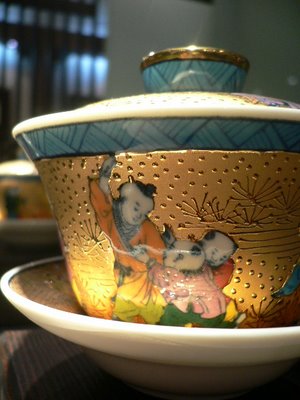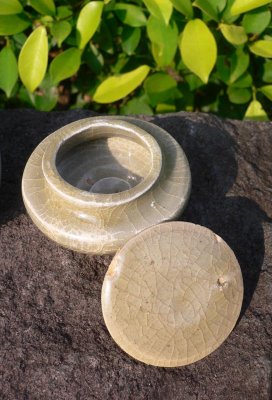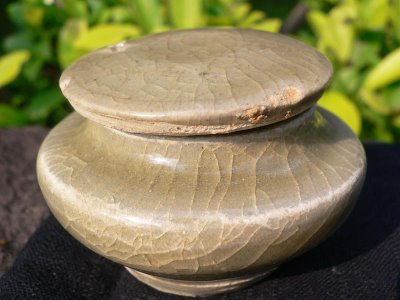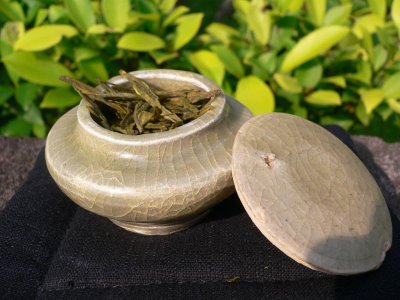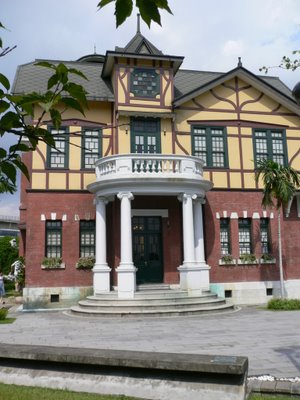
Last Tuesday was Chinese Father Day (each year on August 8, because the 8th day of the 8th month is pronounced Ba Ba or Papa). So, as a way to celebrate, I had the afternoon off and did what I like most: searching excellent tea. Teaparker had recently given me the coordinates where I could buy some Da Yu Ling Oolong from the highest plantation (2650 meters). A friend in NYC had asked me for this tea some time ago, and so I had one more reason to go.
I was lucky: a thunderstorm had kept other customers away and I was alone with the owner. He only had 300 grams of this highest Da Yu Ling left. And it turned out that these were not 2006 or 2005, but spring 2004 harvest leaves. (This year was very rainy and the quality of most late harvested Oolongs was average because of this. That’s why he only had bought very little Da Yu Ling this year and that was already sold out). Anyway, I bought the tea without tasting, fully confident in the reliability of this tea merchant (friend of Teaparker). But actually, I should have tried it first. This would have avoided me calling him 2 days later.
Yesterday, I sat down to taste this ‘top of the world’ Oolong and chose to compare it to my other Da Yu Ling (2200 meters), a very green, lightly oxidized high mountain oolong with a fresh lavender fragrance. I thought ‘top of the world’ would be in the same category, just more concentrated and powerful. It turned out to be very different. The leaves were red on the edges and the color of the tea in my cup was gold instead of green. This is a classic Dong Ding taste, not a high mountain taste. It does taste very good, though. In terms of quality, it reminded me of a third place competition Oolong from Dong Ding I received 3 years ago. The Da Yu Ling was even purer.
On the phone, this master explained again what we had talked about the other day in his shop. He makes all his oolongs according to more traditional process parameters. That means a stronger fermentation and, often, but not necessarily, a longer, low fire roasting. While most of the high mountain oolong on the market is very green (low fermentation and almost no roasting), he insists that this is not how Oolong should be made and taste. First, such oolongs are usually rough on your stomach. Second, their aromas tend to be short lived: once the pack is opened, the leaves will loose their freshness within 6 months. Said differently, this means that, unlike puerh, such leaves won’t improve with time. Third, such oolongs are sought after for their fine fragrance, while traditional oolongs are strong on a lingering dry and sweet finish.
He is one of the few tea makers to use these traditional parameters with high mountain oolongs. This is quite daring. There are the risks and additional costs associated with spending a longer time oxidizing and roasting the tea. A little mistake could ruin very expensive leaves. So, his tea ends up being relatively more expensive than mainstream ‘green’ Oolong. While I agree with him that this is also a characteristic I like and often prefer, I also like the modern tasting high mountain oolongs, especially in summer.
As I was on my way out, he asked me to stay a little longer to smell a 10 year old Oolong from Li Shan. It was kept in a rough clay jar with black glazing. Guess how this traditionally processed smelled? Like brandy. Had he opened a bottle of German brandy, the smell would have been the same. I usually encounter this very smell in chocolate with alcohol. I swear I’m not making this up. He said he could only achieve this post fermentation result because he used the highest quality leaves with sufficient fermentation and roasting. (The jar was already sold out and didn’t belong to him anymore).
This was a very good way to prove his point. With such teas age is indeed much less an issue. Count on me to pay him another visit and see which of his (older) high mountain Oolongs I could add to my selection.
Actually, most of my Oolongs are already more ‘traditional’:
- 2006 Spring Ali Shan roasted Jinxuan Oolong (1400 meters)
- 2006 Spring Feng Huang, Dong Ding Oolong ‘classic’ w/light roast
- 2006 Spring Feng Huang, Dong Ding Oolong ‘fruity’ w/stronger oxidation
- 2005 Summer Guei Fei, Concubine Oolong from Dong Ding
- 2005 Summer Oriental Beauty from hsin Chu county
- Spring 2005 Top grade Tie Kuan Yin from Fujian, Mainland China.
- Spring 2005 strongly roasted Tie Kuan Yin from Anxi, Fujian.
- Spring 2005 strongly roasted Shui Xian from Wu Yi Mountain.
- 2006 Spring Top grade ‘subtropical forest’ Baozhong.
- 2006 Spring Top Grade Qizhong oolong.
- 2006 Spring Top Grade Shou Cha.
- 1980s top grade luanze Oolong from Dong Ding,
- 1960's old medium grade Wen Shan Baozhong,
- 1960s top grade Wen Shan Baozhong.
The following are the ‘modern’, light Oolongs:
- 2006 Spring Da Yu Ling Luanze Oolong (2200 meters)
- 2006 Spring Tsui Feng Luanze Oolong (2000 meters)
- 2006 Spring Shan Lin Shi Luanze Oolong (1650 meters)
- 2006 Spring Si Ji Chun Oolong from Ming Jian
- 2006 Spring Tsui Yu, Jade Oolong from Ming Jian
- 2006 Spring high quality ‘lily flower’ Baozhong.
 J'ai une petite gastro qui m'empêche de boire du thé cette semaine. Cela et le magazine de thé en préparation expliquent pourquoi je fais une petite pause sur mon blog. J'en profite pour vous montrer rapidement que le thé peut aussi tomber malade. Ainsi, on voit assez clairement sur la première photo comment les feuilles qui pointent vers le ciel se portent bien. Mais sur la photo du bas, les feuilles sont presque horizontales et se sentent patraques.
J'ai une petite gastro qui m'empêche de boire du thé cette semaine. Cela et le magazine de thé en préparation expliquent pourquoi je fais une petite pause sur mon blog. J'en profite pour vous montrer rapidement que le thé peut aussi tomber malade. Ainsi, on voit assez clairement sur la première photo comment les feuilles qui pointent vers le ciel se portent bien. Mais sur la photo du bas, les feuilles sont presque horizontales et se sentent patraques. 




